Cultural Differences in Business Communication: India & Australia
VerifiedAdded on 2023/06/09
|6
|1786
|279
Essay
AI Summary
This essay delves into the critical role of effective communication in the business world, particularly within the context of globalization and cross-cultural interactions. It highlights how cultural differences, such as those between India and Australia, can lead to misunderstandings and hinder business prospects. The essay explores the contrasting cultural values of India and Australia, referencing Hofstede's cultural dimensions to illustrate differences in individualism versus collectivism, attitudes toward hierarchy, work-life balance, and risk tolerance. Through a case study of Mary, a business owner seeking to expand into India, the essay provides practical recommendations for navigating these cultural nuances. Mary is advised to adopt a collaborative approach, demonstrate respect for hierarchy, focus on long-term goals, and consider traditional business practices. The essay concludes by emphasizing the importance of cultural awareness and effective communication strategies for international business success, making a strong case for understanding cultural nuances to overcome communication barriers and foster successful global ventures.
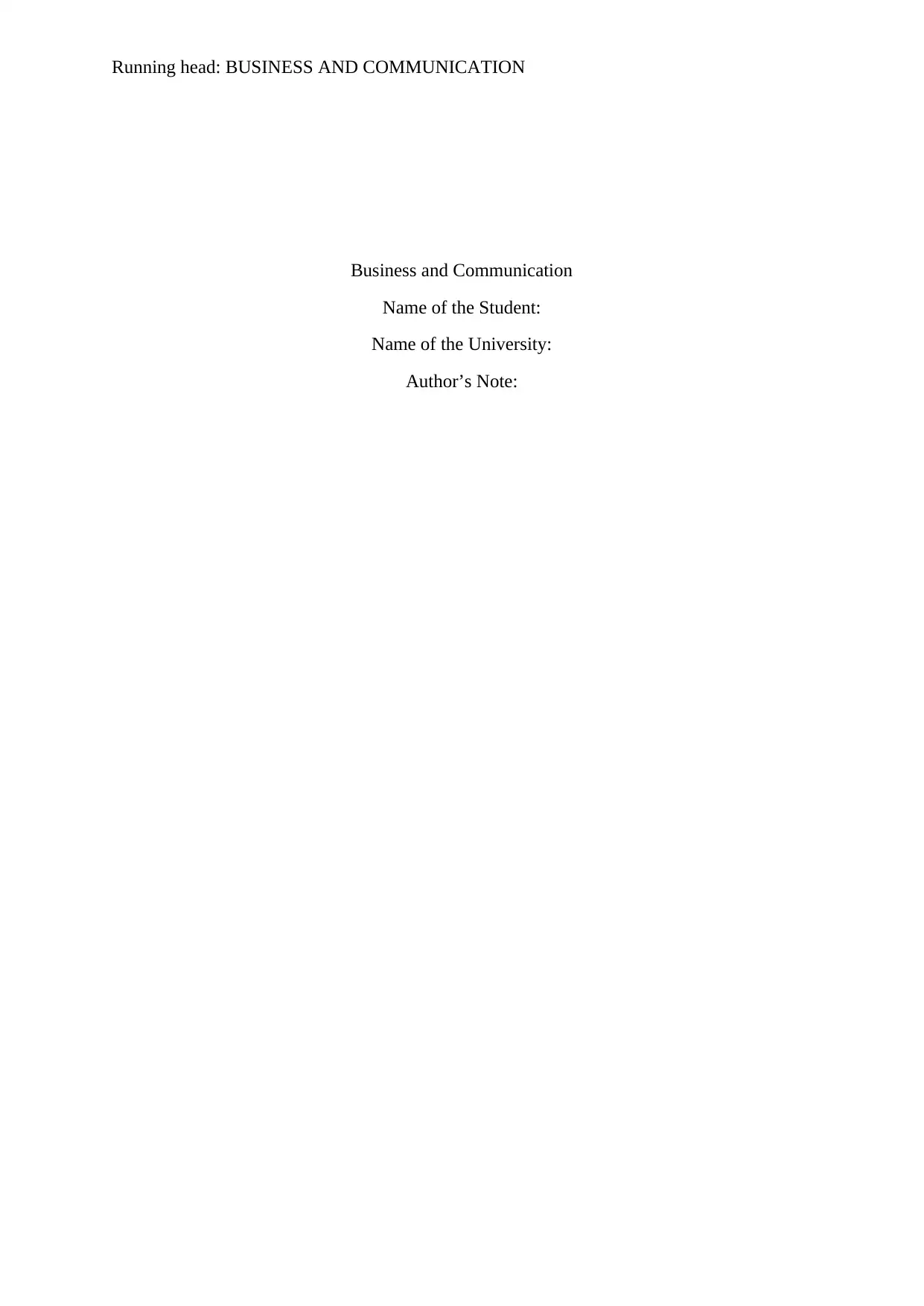
Running head: BUSINESS AND COMMUNICATION
Business and Communication
Name of the Student:
Name of the University:
Author’s Note:
Business and Communication
Name of the Student:
Name of the University:
Author’s Note:
Paraphrase This Document
Need a fresh take? Get an instant paraphrase of this document with our AI Paraphraser
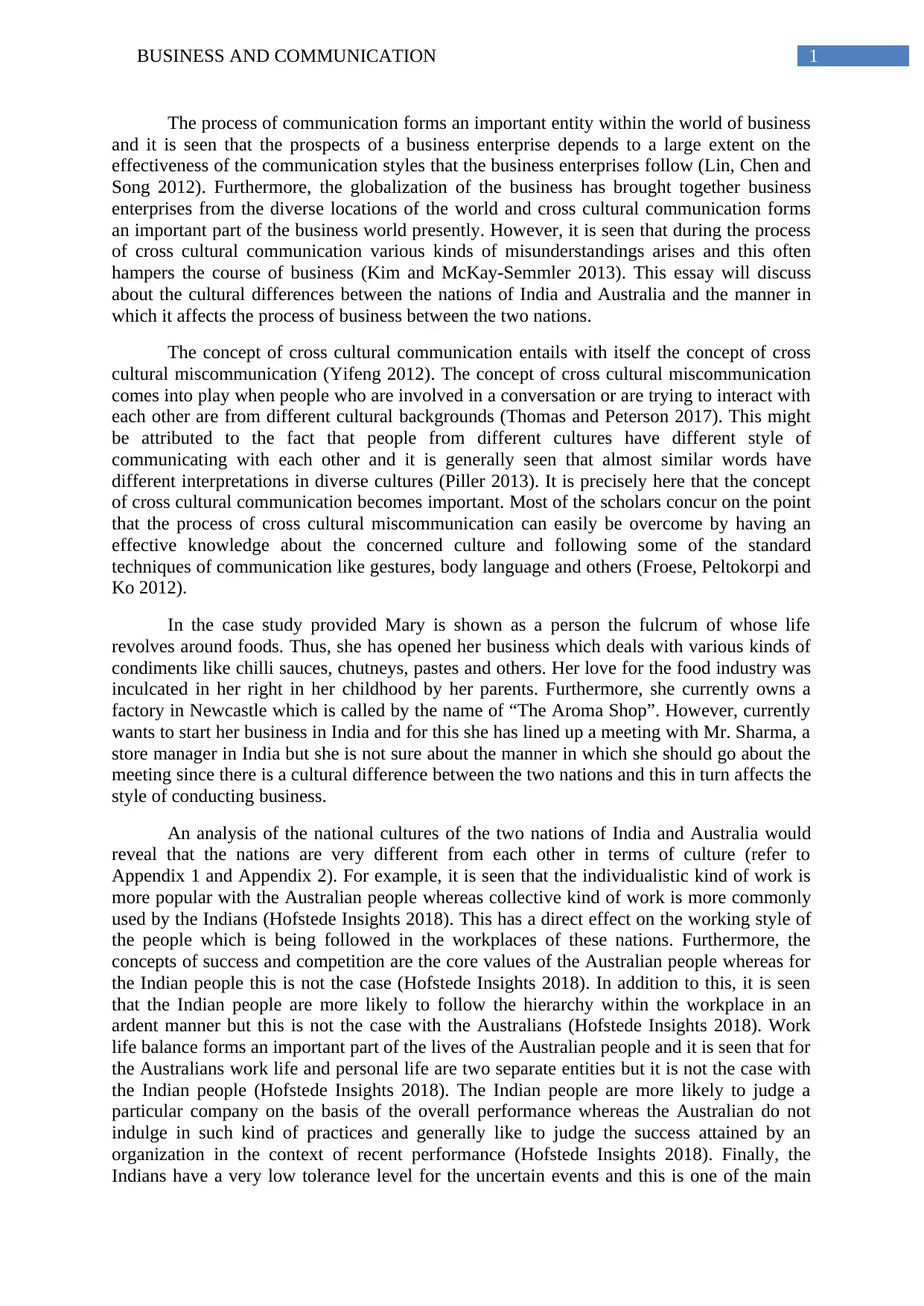
1BUSINESS AND COMMUNICATION
The process of communication forms an important entity within the world of business
and it is seen that the prospects of a business enterprise depends to a large extent on the
effectiveness of the communication styles that the business enterprises follow (Lin, Chen and
Song 2012). Furthermore, the globalization of the business has brought together business
enterprises from the diverse locations of the world and cross cultural communication forms
an important part of the business world presently. However, it is seen that during the process
of cross cultural communication various kinds of misunderstandings arises and this often
hampers the course of business (Kim and McKay-Semmler 2013). This essay will discuss
about the cultural differences between the nations of India and Australia and the manner in
which it affects the process of business between the two nations.
The concept of cross cultural communication entails with itself the concept of cross
cultural miscommunication (Yifeng 2012). The concept of cross cultural miscommunication
comes into play when people who are involved in a conversation or are trying to interact with
each other are from different cultural backgrounds (Thomas and Peterson 2017). This might
be attributed to the fact that people from different cultures have different style of
communicating with each other and it is generally seen that almost similar words have
different interpretations in diverse cultures (Piller 2013). It is precisely here that the concept
of cross cultural communication becomes important. Most of the scholars concur on the point
that the process of cross cultural miscommunication can easily be overcome by having an
effective knowledge about the concerned culture and following some of the standard
techniques of communication like gestures, body language and others (Froese, Peltokorpi and
Ko 2012).
In the case study provided Mary is shown as a person the fulcrum of whose life
revolves around foods. Thus, she has opened her business which deals with various kinds of
condiments like chilli sauces, chutneys, pastes and others. Her love for the food industry was
inculcated in her right in her childhood by her parents. Furthermore, she currently owns a
factory in Newcastle which is called by the name of “The Aroma Shop”. However, currently
wants to start her business in India and for this she has lined up a meeting with Mr. Sharma, a
store manager in India but she is not sure about the manner in which she should go about the
meeting since there is a cultural difference between the two nations and this in turn affects the
style of conducting business.
An analysis of the national cultures of the two nations of India and Australia would
reveal that the nations are very different from each other in terms of culture (refer to
Appendix 1 and Appendix 2). For example, it is seen that the individualistic kind of work is
more popular with the Australian people whereas collective kind of work is more commonly
used by the Indians (Hofstede Insights 2018). This has a direct effect on the working style of
the people which is being followed in the workplaces of these nations. Furthermore, the
concepts of success and competition are the core values of the Australian people whereas for
the Indian people this is not the case (Hofstede Insights 2018). In addition to this, it is seen
that the Indian people are more likely to follow the hierarchy within the workplace in an
ardent manner but this is not the case with the Australians (Hofstede Insights 2018). Work
life balance forms an important part of the lives of the Australian people and it is seen that for
the Australians work life and personal life are two separate entities but it is not the case with
the Indian people (Hofstede Insights 2018). The Indian people are more likely to judge a
particular company on the basis of the overall performance whereas the Australian do not
indulge in such kind of practices and generally like to judge the success attained by an
organization in the context of recent performance (Hofstede Insights 2018). Finally, the
Indians have a very low tolerance level for the uncertain events and this is one of the main
The process of communication forms an important entity within the world of business
and it is seen that the prospects of a business enterprise depends to a large extent on the
effectiveness of the communication styles that the business enterprises follow (Lin, Chen and
Song 2012). Furthermore, the globalization of the business has brought together business
enterprises from the diverse locations of the world and cross cultural communication forms
an important part of the business world presently. However, it is seen that during the process
of cross cultural communication various kinds of misunderstandings arises and this often
hampers the course of business (Kim and McKay-Semmler 2013). This essay will discuss
about the cultural differences between the nations of India and Australia and the manner in
which it affects the process of business between the two nations.
The concept of cross cultural communication entails with itself the concept of cross
cultural miscommunication (Yifeng 2012). The concept of cross cultural miscommunication
comes into play when people who are involved in a conversation or are trying to interact with
each other are from different cultural backgrounds (Thomas and Peterson 2017). This might
be attributed to the fact that people from different cultures have different style of
communicating with each other and it is generally seen that almost similar words have
different interpretations in diverse cultures (Piller 2013). It is precisely here that the concept
of cross cultural communication becomes important. Most of the scholars concur on the point
that the process of cross cultural miscommunication can easily be overcome by having an
effective knowledge about the concerned culture and following some of the standard
techniques of communication like gestures, body language and others (Froese, Peltokorpi and
Ko 2012).
In the case study provided Mary is shown as a person the fulcrum of whose life
revolves around foods. Thus, she has opened her business which deals with various kinds of
condiments like chilli sauces, chutneys, pastes and others. Her love for the food industry was
inculcated in her right in her childhood by her parents. Furthermore, she currently owns a
factory in Newcastle which is called by the name of “The Aroma Shop”. However, currently
wants to start her business in India and for this she has lined up a meeting with Mr. Sharma, a
store manager in India but she is not sure about the manner in which she should go about the
meeting since there is a cultural difference between the two nations and this in turn affects the
style of conducting business.
An analysis of the national cultures of the two nations of India and Australia would
reveal that the nations are very different from each other in terms of culture (refer to
Appendix 1 and Appendix 2). For example, it is seen that the individualistic kind of work is
more popular with the Australian people whereas collective kind of work is more commonly
used by the Indians (Hofstede Insights 2018). This has a direct effect on the working style of
the people which is being followed in the workplaces of these nations. Furthermore, the
concepts of success and competition are the core values of the Australian people whereas for
the Indian people this is not the case (Hofstede Insights 2018). In addition to this, it is seen
that the Indian people are more likely to follow the hierarchy within the workplace in an
ardent manner but this is not the case with the Australians (Hofstede Insights 2018). Work
life balance forms an important part of the lives of the Australian people and it is seen that for
the Australians work life and personal life are two separate entities but it is not the case with
the Indian people (Hofstede Insights 2018). The Indian people are more likely to judge a
particular company on the basis of the overall performance whereas the Australian do not
indulge in such kind of practices and generally like to judge the success attained by an
organization in the context of recent performance (Hofstede Insights 2018). Finally, the
Indians have a very low tolerance level for the uncertain events and this is one of the main
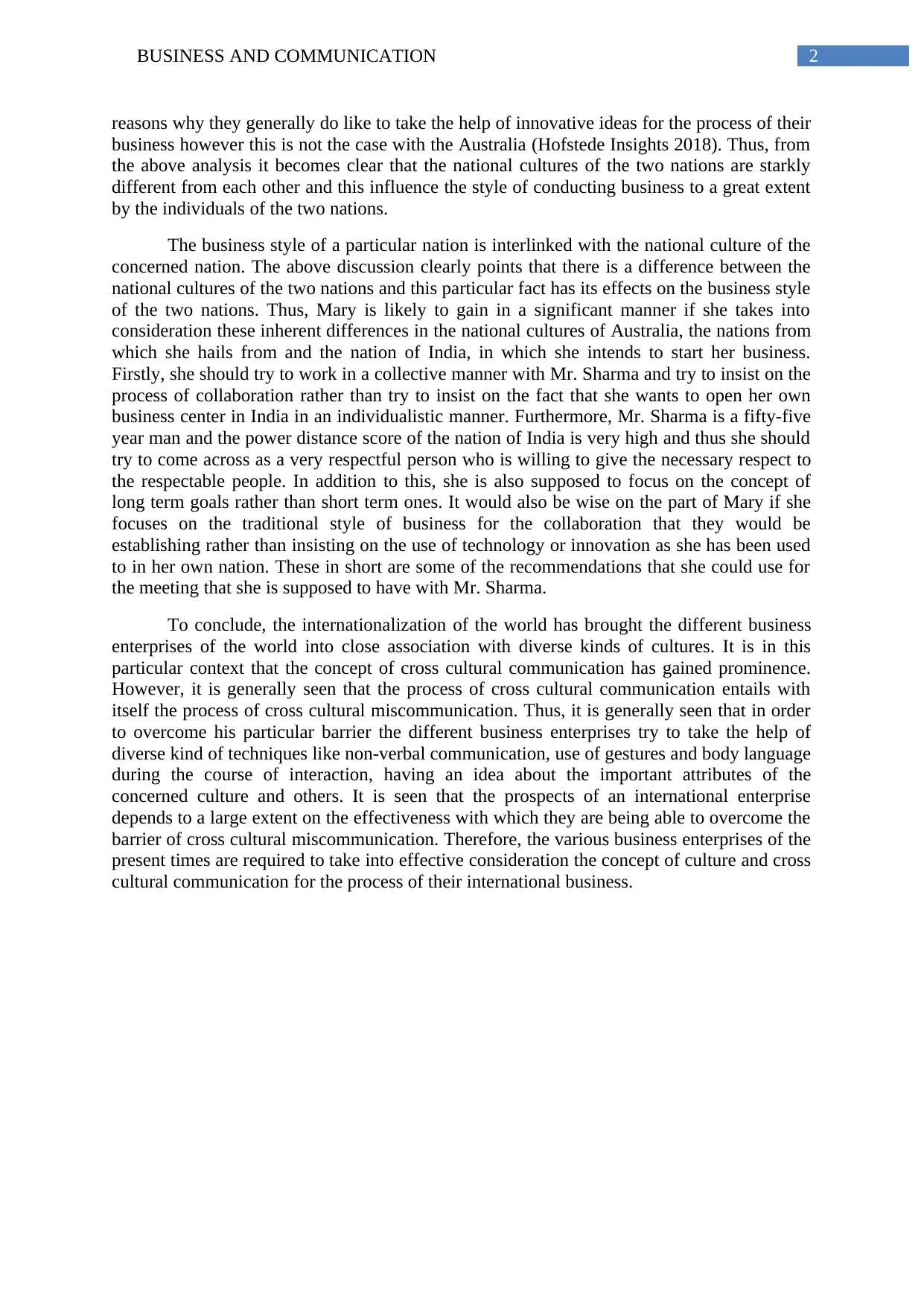
2BUSINESS AND COMMUNICATION
reasons why they generally do like to take the help of innovative ideas for the process of their
business however this is not the case with the Australia (Hofstede Insights 2018). Thus, from
the above analysis it becomes clear that the national cultures of the two nations are starkly
different from each other and this influence the style of conducting business to a great extent
by the individuals of the two nations.
The business style of a particular nation is interlinked with the national culture of the
concerned nation. The above discussion clearly points that there is a difference between the
national cultures of the two nations and this particular fact has its effects on the business style
of the two nations. Thus, Mary is likely to gain in a significant manner if she takes into
consideration these inherent differences in the national cultures of Australia, the nations from
which she hails from and the nation of India, in which she intends to start her business.
Firstly, she should try to work in a collective manner with Mr. Sharma and try to insist on the
process of collaboration rather than try to insist on the fact that she wants to open her own
business center in India in an individualistic manner. Furthermore, Mr. Sharma is a fifty-five
year man and the power distance score of the nation of India is very high and thus she should
try to come across as a very respectful person who is willing to give the necessary respect to
the respectable people. In addition to this, she is also supposed to focus on the concept of
long term goals rather than short term ones. It would also be wise on the part of Mary if she
focuses on the traditional style of business for the collaboration that they would be
establishing rather than insisting on the use of technology or innovation as she has been used
to in her own nation. These in short are some of the recommendations that she could use for
the meeting that she is supposed to have with Mr. Sharma.
To conclude, the internationalization of the world has brought the different business
enterprises of the world into close association with diverse kinds of cultures. It is in this
particular context that the concept of cross cultural communication has gained prominence.
However, it is generally seen that the process of cross cultural communication entails with
itself the process of cross cultural miscommunication. Thus, it is generally seen that in order
to overcome his particular barrier the different business enterprises try to take the help of
diverse kind of techniques like non-verbal communication, use of gestures and body language
during the course of interaction, having an idea about the important attributes of the
concerned culture and others. It is seen that the prospects of an international enterprise
depends to a large extent on the effectiveness with which they are being able to overcome the
barrier of cross cultural miscommunication. Therefore, the various business enterprises of the
present times are required to take into effective consideration the concept of culture and cross
cultural communication for the process of their international business.
reasons why they generally do like to take the help of innovative ideas for the process of their
business however this is not the case with the Australia (Hofstede Insights 2018). Thus, from
the above analysis it becomes clear that the national cultures of the two nations are starkly
different from each other and this influence the style of conducting business to a great extent
by the individuals of the two nations.
The business style of a particular nation is interlinked with the national culture of the
concerned nation. The above discussion clearly points that there is a difference between the
national cultures of the two nations and this particular fact has its effects on the business style
of the two nations. Thus, Mary is likely to gain in a significant manner if she takes into
consideration these inherent differences in the national cultures of Australia, the nations from
which she hails from and the nation of India, in which she intends to start her business.
Firstly, she should try to work in a collective manner with Mr. Sharma and try to insist on the
process of collaboration rather than try to insist on the fact that she wants to open her own
business center in India in an individualistic manner. Furthermore, Mr. Sharma is a fifty-five
year man and the power distance score of the nation of India is very high and thus she should
try to come across as a very respectful person who is willing to give the necessary respect to
the respectable people. In addition to this, she is also supposed to focus on the concept of
long term goals rather than short term ones. It would also be wise on the part of Mary if she
focuses on the traditional style of business for the collaboration that they would be
establishing rather than insisting on the use of technology or innovation as she has been used
to in her own nation. These in short are some of the recommendations that she could use for
the meeting that she is supposed to have with Mr. Sharma.
To conclude, the internationalization of the world has brought the different business
enterprises of the world into close association with diverse kinds of cultures. It is in this
particular context that the concept of cross cultural communication has gained prominence.
However, it is generally seen that the process of cross cultural communication entails with
itself the process of cross cultural miscommunication. Thus, it is generally seen that in order
to overcome his particular barrier the different business enterprises try to take the help of
diverse kind of techniques like non-verbal communication, use of gestures and body language
during the course of interaction, having an idea about the important attributes of the
concerned culture and others. It is seen that the prospects of an international enterprise
depends to a large extent on the effectiveness with which they are being able to overcome the
barrier of cross cultural miscommunication. Therefore, the various business enterprises of the
present times are required to take into effective consideration the concept of culture and cross
cultural communication for the process of their international business.
⊘ This is a preview!⊘
Do you want full access?
Subscribe today to unlock all pages.

Trusted by 1+ million students worldwide
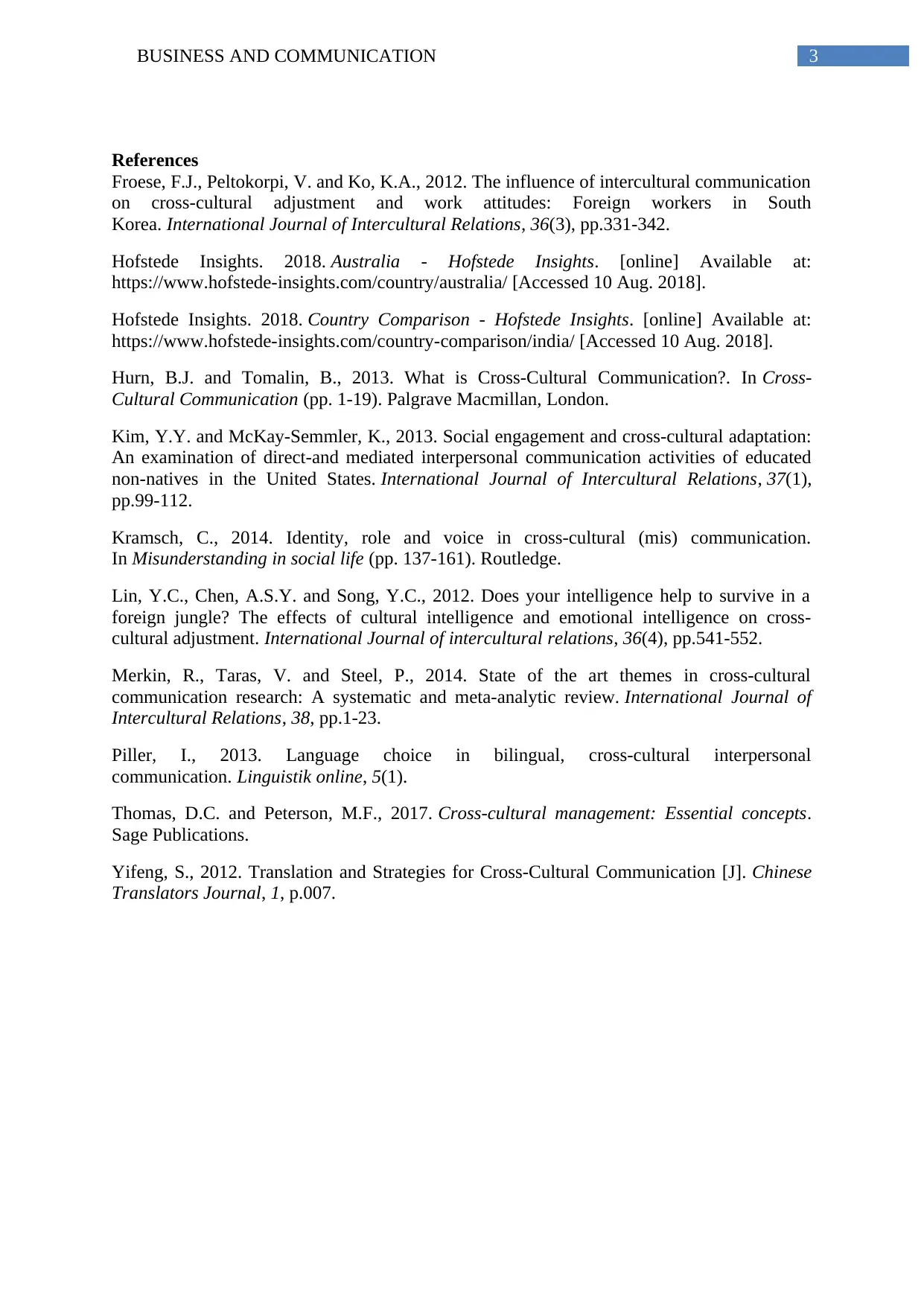
3BUSINESS AND COMMUNICATION
References
Froese, F.J., Peltokorpi, V. and Ko, K.A., 2012. The influence of intercultural communication
on cross-cultural adjustment and work attitudes: Foreign workers in South
Korea. International Journal of Intercultural Relations, 36(3), pp.331-342.
Hofstede Insights. 2018. Australia - Hofstede Insights. [online] Available at:
https://www.hofstede-insights.com/country/australia/ [Accessed 10 Aug. 2018].
Hofstede Insights. 2018. Country Comparison - Hofstede Insights. [online] Available at:
https://www.hofstede-insights.com/country-comparison/india/ [Accessed 10 Aug. 2018].
Hurn, B.J. and Tomalin, B., 2013. What is Cross-Cultural Communication?. In Cross-
Cultural Communication (pp. 1-19). Palgrave Macmillan, London.
Kim, Y.Y. and McKay-Semmler, K., 2013. Social engagement and cross-cultural adaptation:
An examination of direct-and mediated interpersonal communication activities of educated
non-natives in the United States. International Journal of Intercultural Relations, 37(1),
pp.99-112.
Kramsch, C., 2014. Identity, role and voice in cross-cultural (mis) communication.
In Misunderstanding in social life (pp. 137-161). Routledge.
Lin, Y.C., Chen, A.S.Y. and Song, Y.C., 2012. Does your intelligence help to survive in a
foreign jungle? The effects of cultural intelligence and emotional intelligence on cross-
cultural adjustment. International Journal of intercultural relations, 36(4), pp.541-552.
Merkin, R., Taras, V. and Steel, P., 2014. State of the art themes in cross-cultural
communication research: A systematic and meta-analytic review. International Journal of
Intercultural Relations, 38, pp.1-23.
Piller, I., 2013. Language choice in bilingual, cross-cultural interpersonal
communication. Linguistik online, 5(1).
Thomas, D.C. and Peterson, M.F., 2017. Cross-cultural management: Essential concepts.
Sage Publications.
Yifeng, S., 2012. Translation and Strategies for Cross-Cultural Communication [J]. Chinese
Translators Journal, 1, p.007.
References
Froese, F.J., Peltokorpi, V. and Ko, K.A., 2012. The influence of intercultural communication
on cross-cultural adjustment and work attitudes: Foreign workers in South
Korea. International Journal of Intercultural Relations, 36(3), pp.331-342.
Hofstede Insights. 2018. Australia - Hofstede Insights. [online] Available at:
https://www.hofstede-insights.com/country/australia/ [Accessed 10 Aug. 2018].
Hofstede Insights. 2018. Country Comparison - Hofstede Insights. [online] Available at:
https://www.hofstede-insights.com/country-comparison/india/ [Accessed 10 Aug. 2018].
Hurn, B.J. and Tomalin, B., 2013. What is Cross-Cultural Communication?. In Cross-
Cultural Communication (pp. 1-19). Palgrave Macmillan, London.
Kim, Y.Y. and McKay-Semmler, K., 2013. Social engagement and cross-cultural adaptation:
An examination of direct-and mediated interpersonal communication activities of educated
non-natives in the United States. International Journal of Intercultural Relations, 37(1),
pp.99-112.
Kramsch, C., 2014. Identity, role and voice in cross-cultural (mis) communication.
In Misunderstanding in social life (pp. 137-161). Routledge.
Lin, Y.C., Chen, A.S.Y. and Song, Y.C., 2012. Does your intelligence help to survive in a
foreign jungle? The effects of cultural intelligence and emotional intelligence on cross-
cultural adjustment. International Journal of intercultural relations, 36(4), pp.541-552.
Merkin, R., Taras, V. and Steel, P., 2014. State of the art themes in cross-cultural
communication research: A systematic and meta-analytic review. International Journal of
Intercultural Relations, 38, pp.1-23.
Piller, I., 2013. Language choice in bilingual, cross-cultural interpersonal
communication. Linguistik online, 5(1).
Thomas, D.C. and Peterson, M.F., 2017. Cross-cultural management: Essential concepts.
Sage Publications.
Yifeng, S., 2012. Translation and Strategies for Cross-Cultural Communication [J]. Chinese
Translators Journal, 1, p.007.
Paraphrase This Document
Need a fresh take? Get an instant paraphrase of this document with our AI Paraphraser
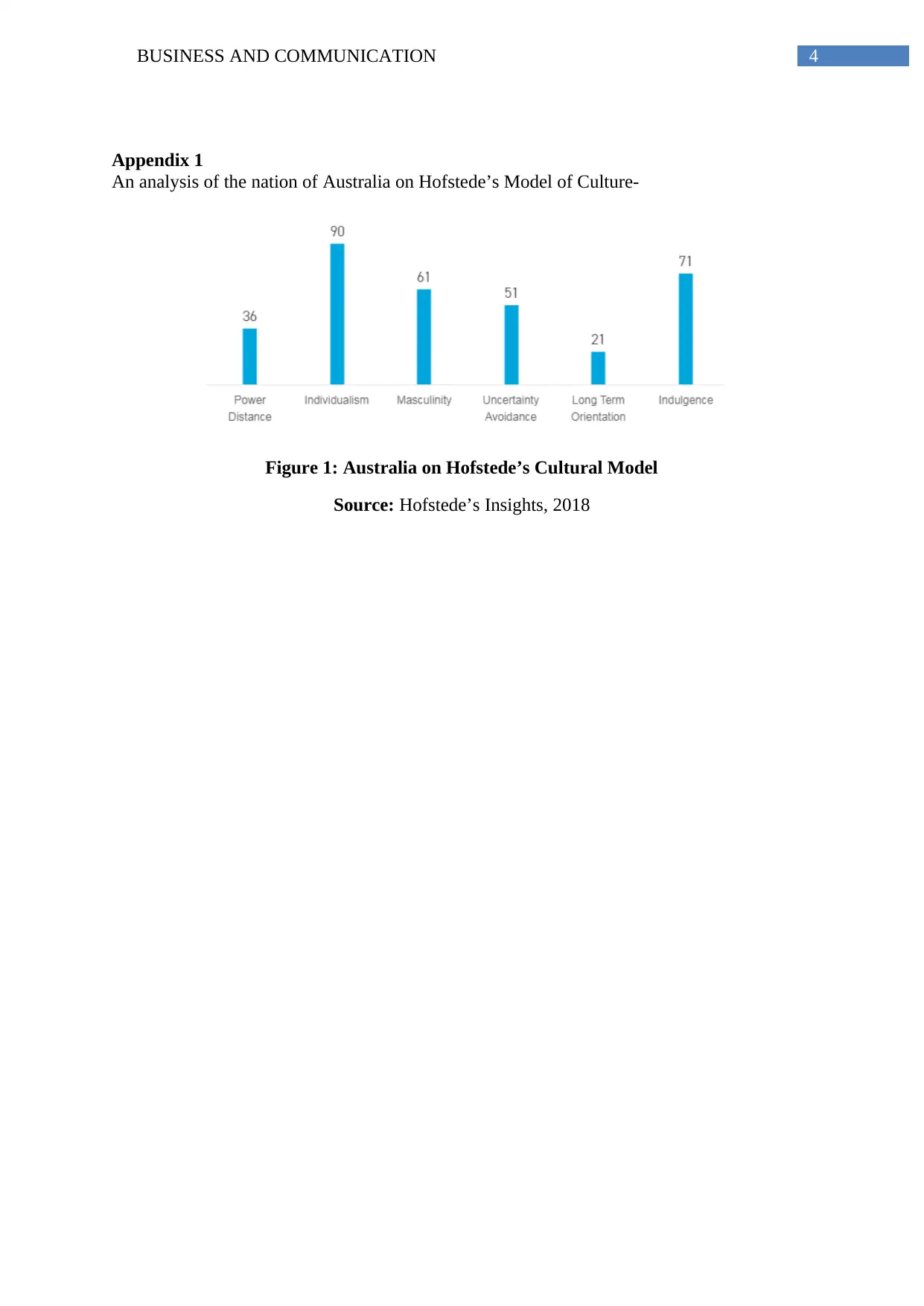
4BUSINESS AND COMMUNICATION
Appendix 1
An analysis of the nation of Australia on Hofstede’s Model of Culture-
Figure 1: Australia on Hofstede’s Cultural Model
Source: Hofstede’s Insights, 2018
Appendix 1
An analysis of the nation of Australia on Hofstede’s Model of Culture-
Figure 1: Australia on Hofstede’s Cultural Model
Source: Hofstede’s Insights, 2018
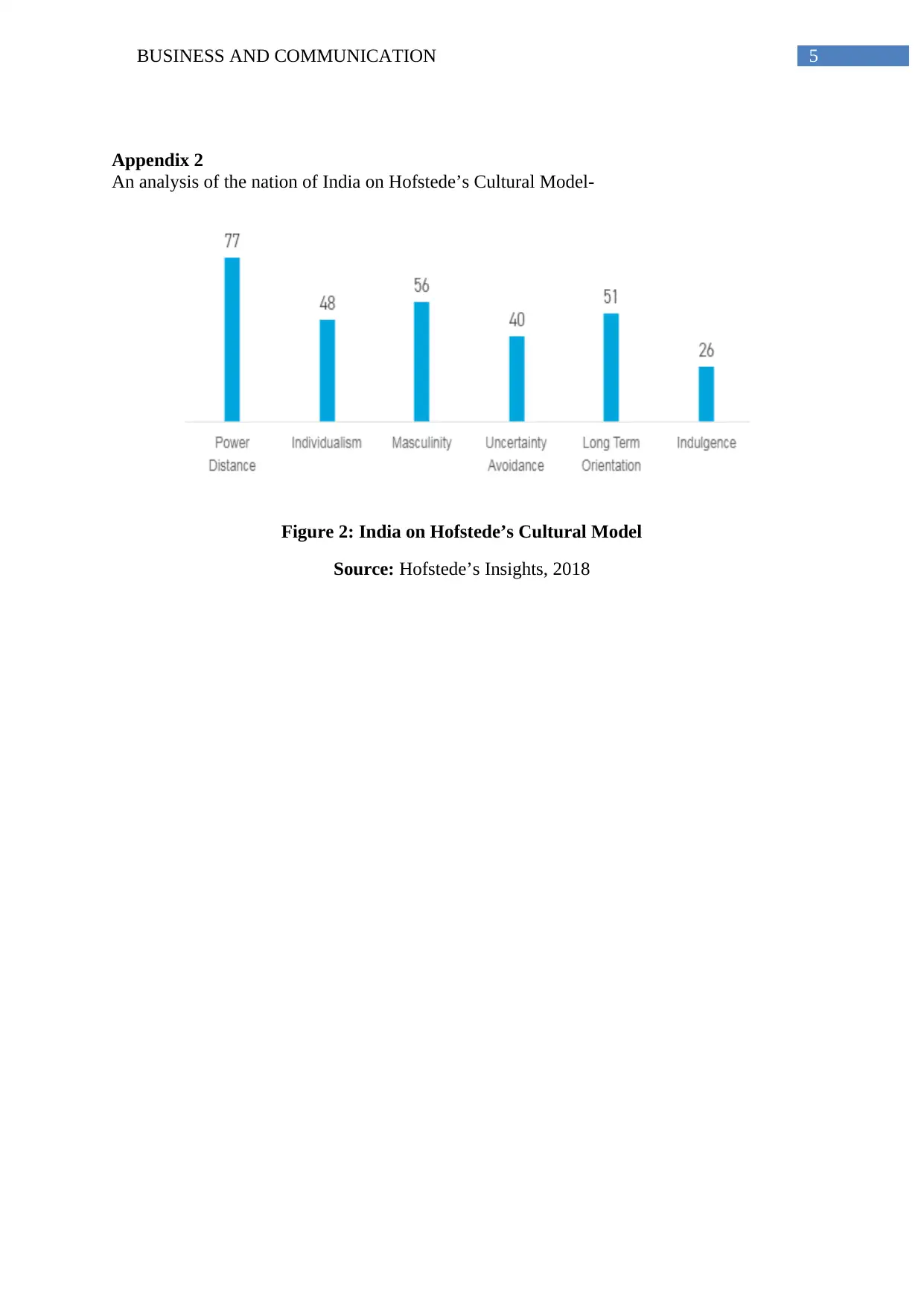
5BUSINESS AND COMMUNICATION
Appendix 2
An analysis of the nation of India on Hofstede’s Cultural Model-
Figure 2: India on Hofstede’s Cultural Model
Source: Hofstede’s Insights, 2018
Appendix 2
An analysis of the nation of India on Hofstede’s Cultural Model-
Figure 2: India on Hofstede’s Cultural Model
Source: Hofstede’s Insights, 2018
⊘ This is a preview!⊘
Do you want full access?
Subscribe today to unlock all pages.

Trusted by 1+ million students worldwide
1 out of 6
Related Documents
Your All-in-One AI-Powered Toolkit for Academic Success.
+13062052269
info@desklib.com
Available 24*7 on WhatsApp / Email
![[object Object]](/_next/static/media/star-bottom.7253800d.svg)
Unlock your academic potential
Copyright © 2020–2025 A2Z Services. All Rights Reserved. Developed and managed by ZUCOL.




